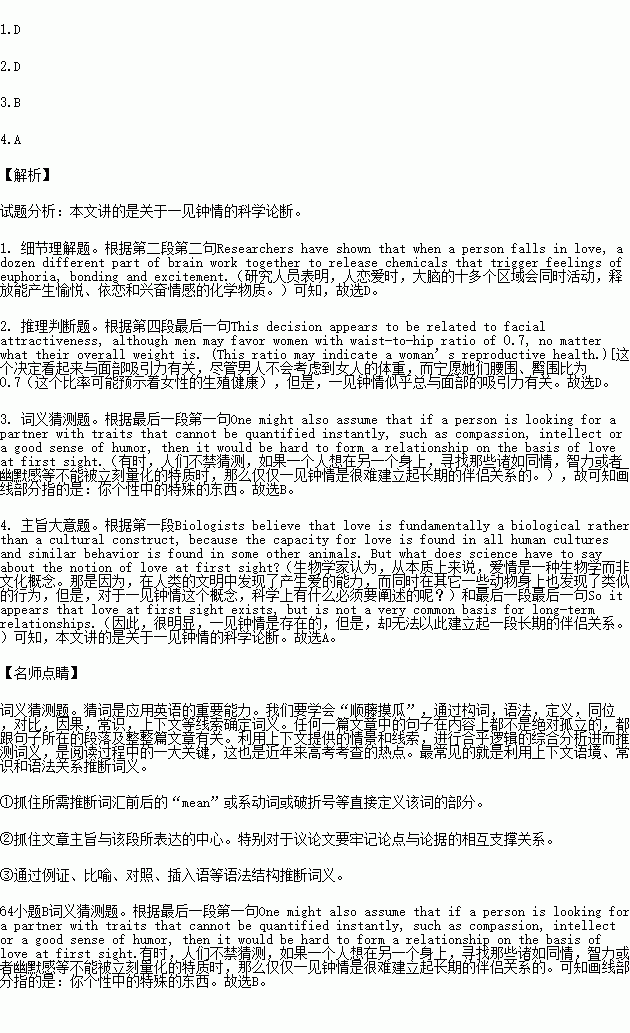题目内容
Biologists believe that love is fundamentally a biological rather than a cultural construct, because the capacity for love is found in all human cultures and similar behavior is found in some other animals. In humans the purpose of all the desire is to focus attention on the raising of offspring. Children demand an unusual amount of parenting, and two parents are better than one. Love is a signal that both partners are committed, and makes it more likely that this commitment will continue as long as necessary for children to reach independence. But what does science have to say about the notion of love at first sight?
In recent years the ability to watch the brain in action has offered a wealth of insight into the mechanics of love. Researchers have shown that when a person falls in love, a dozen different part of brain work together to release chemicals that trigger feelings of euphoria, bonding and excitement. It has also been shown that the unconditional love between a mother and a child is associated with activity in different regions of the brain from those associated with pair-bonding love.
Passionate love is rooted in the reward circuitry of the brain—the same area that is active when humans feel a rush from cocaine. In fact, the desire, motivations and withdrawals involved in love have a great deal in common with addiction. Its most intense forms tend to be associated with the early stages of a relationship, which then give way to a calmer attachment form of love one feels with a long term partner.
What all this means is that one special person can become chemically rewarding to the brain of another. Love at first sight, then, is only possible if the mechanism for generating long-term attachment can be triggered quickly. There are signs that it can be. One line of evidence is that people are able to decide within a second how attractive they find another person. This decision appears to be related to facial attractiveness, although men may favor women with waist-to-hip ratio of 0.7, no matter what their overall weight is. (This ratio may indicate a woman’s reproductive health.)
Another piece of evidence comes from work by a psychologist at Ben-Gurion University, who found in a survey that a small percentage (11%) of people in long-term relationships said that they began with love at first sight. In other words, in some couples the initial favorable impressions of attractiveness triggered love which sustained a lengthy bond. It is also clear that some couples need to form their bonds over a longer period, and popular culture tells many tales of friends who become lovers.
One might also assume that if a person is looking for a partner with traits that cannot be quantified instantly, such as compassion, intellect or a good sense of humor, then it would be hard to form a relationship on the basis of love at first sight. Those more concerned with visual appearances, though, might find this easier. So it appears that love at first sight exists, but is not a very common basis for long-term relationships.
1.When a person falls in love, ________.
A. he feels as if he were addicted to cocaine
B. he will be committed to the beloved as long as necessary
C. he will experience a calmer attachment form of love before he feels the extreme love
D. he will experience complex feelings brought on by different regions of his brain
2.We can infer from the passage that ________.
A. pair-bonding love comes from a long stable friendship
B. the mechanism for creating long-term attachment ensures love at first sight
C. it is impossible for those ordinary-looking people to fall in love at first sight
D. men may be attracted by a girl whose figure suggests her admirable reproductive capacity
3.The underlined word “traits” in the last paragraph probably means ________.
A. characteristics
B. particular quantities in your personality
C. something typical in your temper
D. attitudes that show your moral standards
4.Which of the following may be the best title of the passage?
A. The science of love at first sight
B. The stages of passionate love
C. The biological construct of pair-bonding
D. The mechanism for generating long-term love

